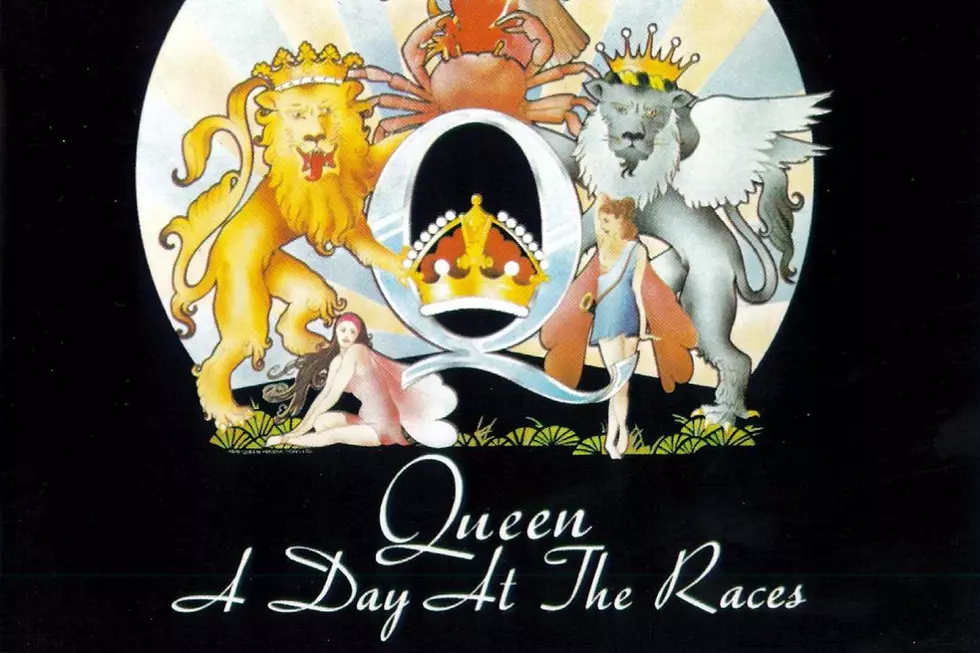
When Queen Attempted to Make a Sequel With ‘A Day at the Races’
How did Queen attempt to follow the grandeur, success and expense of A Night at the Opera? By trying to do it all over again with A Day at the Races, a 1976 sequel to its blockbuster from the previous year that continued the album’s complicated studio techniques, stylistic range and bombastic sound. Not a group to shy away from excess, Queen never thought that you could have too much of a good thing.
The British band spent the bulk of five months in 1976 making what would become their fifth record. As they worked on material, the members began to consider the new album a sequel – hence the title (borrowed from the Marx Brothers’ film that followed the comedy team’s A Night at the Opera) and a similarly styled album cover.
Queen’s Opera had been the most expensive album to date, and drummer Roger Taylor said that Races cost around the same amount, due to the abundance of intricate studio trickery. Yet, the “sequel” differed when it came to the album’s producer. After four albums, all helmed (at least in part) by Roy Thomas Baker, Races would be Queen’s first self-produced disc.
Why Did Queen Produce 'A Day at the Races' Themselves?
“We just felt that, for this one, we needed a bit of a change,” frontman Freddie Mercury told Circus in 1977. “We were quite confident in doing it ourselves. The other albums we really co-produced, actually we always took a very keen interest … Roy’s been great, but it’s a progression, really – another step in our career. We simply felt that it was now or never.”
READ MORE: The Best Song From Every Queen Album
Without Baker, Queen sought to achieve the same dynamism as their previous release, covering plenty of musical ground between hard rock (“Tie Your Mother Down”), soulful pop (“Somebody to Love”), dance hall (“Good Old Fashioned Lover Boy”) and wildly shifting studio creations (“The Millionaire Waltz”). As with Opera, Mercury and guitarist Brian May handled the bulk of the songwriting, with Taylor and bassist John Deacon contributing a song apiece.
Of course, when recording the tunes, it was all hands on deck, especially with such complicated compositions as “The Millionaire Waltz,” with its many time signatures, stacked vocals and symphonic guitar parts. Penned by Mercury about manager John Reid, the song plows the same ground laid by “Bohemian Rhapsody,” although it’s not as widely known as that Queen classic.
“[‘The Millionaire Waltz’] actually would sum up most of what we were about,” May told Cuepoint in 2014. “But it’s something that’s very seldom played, I think it was almost like the successor to ‘Bohemian Rhapsody.’ It’s so incredibly complex that it doesn’t program on radio, I suppose. But, boy, there’s some stuff in there. It’s a favorite of mine – it’s so extreme!”
May would contribute some of Races’ other extreme tracks, at least when it came to heavy music. Kick-off track “Tie Your Mother Down” would quickly become one of Queen’s aggressive concert favorites while “White Man,” inspired by the plight of Native Americans, would thunder and crunch with the best, swaggering hard rock of the era. The guitarist extraordinaire went a different route with the mild-mannered album-closer “Teo Torriatte (Let Us Cling Together),” written for fans in Japan with some lyrics in Japanese.
Mercury, meanwhile, continued his quest to build mille-feuilles of vocal tracks, creating virtual choirs of his own voice on “You Take My Breath Away” and of his, May’s and Taylor’s vocals on “Somebody to Love.”
'Somebody to Love''s Gospel Roots
Although it was about as complicated a recording as anything Queen had done to that point, “Somebody” had roots in much simpler music: gospel.
“It was all about Aretha Franklin for Freddie,” May told Astronomy magazine in 2012. “She was a huge influence… So it was very much gospel construction and allowed him to sing in the way which he loved.”
Mercury’s love for the song was only matched by the music-buying public’s affection for “Somebody to Love.” When chosen as the lead single, a month prior to the release of A Day at the Races, the track zoomed up the charts, eventually topping out at No. 2 in the U.K. and No. 13 in the U.S. It remains one of the most famous Queen songs.
READ MORE: Queen Albums Ranked Worst to Best
Buoyed by the success of “Somebody to Love,” A Day at the Races became a sizable hit album when it came out on Dec. 10, 1976 in Britain and Europe, and a week later in the States. Earning glowing reviews in the music press, topping the charts in the U.K. and instantly going gold (and later platinum) in the U.S., the album was perceived as a worthy successor to A Night at the Opera. A big world tour followed, which also found the band meeting with Groucho Marx and paying tribute to the comedy legend’s impact on their albums (the titles, at least).
Decades later A Day at the Races remains well-regarded by Queen fans and critics, although it’s not as highly praised as its predecessor. Perhaps the sequel can never quite live up to the original.
Rock Stars Who Walked Away and Never Looked Back
Gallery Credit: UCR Staff
You Think You Know Queen?



